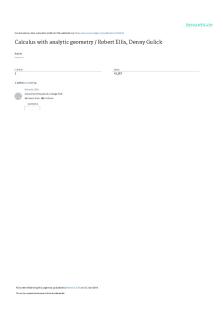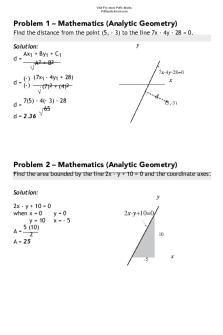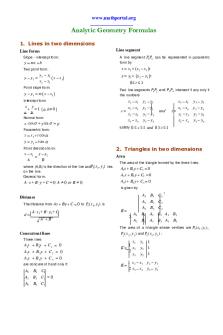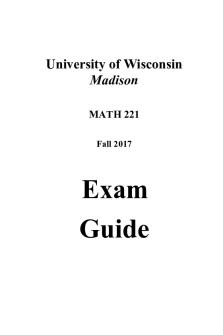Calculus with analytic geometry Robert Ellis Denny PDF

| Title | Calculus with analytic geometry Robert Ellis Denny |
|---|---|
| Course | Introduction to Management |
| Institution | Unity University |
| Pages | 25 |
| File Size | 1.9 MB |
| File Type | |
| Total Downloads | 82 |
| Total Views | 154 |
Summary
Download Calculus with analytic geometry Robert Ellis Denny PDF
Description
See discussions, stats, and author profiles for this publication at: https://www.researchgate.net/publication/44500439
Calculus with analytic geometry / Robert Ellis, Denny Gulick Article Source: OAI
CITATION
READS
1
42,857
2 authors, including: Robert L. Ellis University of Maryland, College Park 46 PUBLICATIONS388 CITATIONS SEE PROFILE
All content following this page was uploaded by Robert L. Ellis on 15 June 2014. The user has requested enhancement of the downloaded file.
AP Calculus BC Syllabus Brief Description of Course: This course is designed to cover two semesters of college calculus material. It covers an extensive study of functions, graphs, limits, derivatives, definite integrals, polynomial approximations and series and applications of all of the above. Each of these topics is approached via the "Rule of Four", with activities that emphasize expressing mathematics from graphical, numerical, analytical, and verbal representations. Maintaining consistency with our district, we will require a formal lab report each quarter that reinforces "The Rule of Four". Unit Information Unit Name or Timeframe: Topic 1 (Chapter 1): Limits and Their Properties (12 Days) Content and/or Skills Taught: - Review properties of functions in context - Graphical interpretation of limits - Numerical calculation of limits - One-sided limits - Properties of limits - Existence of limits - Infinite limits - Limits at Infinity - Continuity - Types of discontinuities - Intermediate Value Theorem Major Assignments and/or Assessments: Problem set on limits at end of submission Unit Name or Timeframe: Topic 2 (Chapters 2, 5, and 9): Differentiation (30 Days) Content and/or Skills Taught: - Limit Definition of the Derivative - Finding Equations of Tangent Lines - Relating the derivative to the slope of the tangent line - Estimating derivatives from tables and graphs - Interpretation of the derivative as an instantaneous rate of change - Graphical interpretation of differentiability / non-differentiability - Differentiability implies continuity, but continuity does not necessarily imply differentiability. - Rules for differentiation: Power, Product, Quotient, Chain - Properties of derivatives
- Implicit differentiation - Related rates - Recognizing the need for the derivative in applied problems - Differentiating exponential, logarithmic, and inverse trigonometric functions - L'Hopital's Rule and Relative Rates of Growth (Exponential, Polynomial, Logarithmic) - Finding the derivative of the inverse of a function at a point - Differentiation of parametric and polar curves Major Assignments and/or Assessments: Problem set on derivatives at end of submission Unit Name or Timeframe: Topic 3 (Chapter 3): Applications of Derivatives (30 Days) Content and/or Skills Taught: - Extreme value theorem - Finding absolute extrema of a function on a closed interval - Increasing and decreasing functions - Analyzing monotonicity of functions - Interpreting the derivative in elementary physics applications, including position, velocity, and acceleration - Rectilinear motion - Finding local extrema by the first and second derivative tests - Rolle's Theorem, The Mean Value Theorem, and their geometric interpretations - Analyzing the relationship between f, f', and f'' by use of sign charts - Determine intervals of concavity and points of inflection - Curve sketching using all of the above information - Using local linear approximations to estimate the value of a function from the tangent line equation - Examine error bound from a local linear approximation - Optimization of functions (local and global) as applied to real-world problems - Applications of optimization to marginal business applications Major Assignments and/or Assessments: Virus lab at end of submission Unit Name or Timeframe: Topic 4 (Chapters 4 and 5): Introduction to Integration and Differential Equations (30 Days) Content and/or Skills Taught: - Antiderivatives as related to derivatives of elementary functions - Rectilinear motion problems requiring antidifferentiation
- Visual interpretation of the family of curves that satisfy a differential equation via slope fields - Finding specific solutions to a differential equation using an initial condition - Review of sigma notation and properties of sigma notation - Examining the definite integral as a Riemann sum using left sums, right sums, midpoint sums, and trapezoidal sums - Develop the definite integral as a limit of these Riemann sums - Properties of definite integrals - First and second Fundamental Theorems of Calculus - Average value of a function from an analytical and graphical approach - Integrating rates of change to give the net change in the function over an arbitrary interval - The Fundamental Theorems of Calculus as accumulation functions, both as accumulated area and in the context of applied problems - Develop the formula for the solution to a differential equation given an initial condition by using the integral as an accumulation function - Integration by u-substitution - Solving separable differential equations, emphasizing exponential growth and decay, interest problems, and Newton's Law of Cooling Major Assignments and/or Assessments: Fundamental Theorem of Calculus packet at end of submission Unit Name or Timeframe: Topic 5 (Chapter 6): Applications of Integration (10 Days) Content and/or Skills Taught: - Finding the area of a region - Finding the area of a region between two curves - Volumes of solids of revolution (disk, washer methods) - Volumes of solids with known cross sections - Arc length of functions of the form y = f(x), x = g(y), and parametrically defined curves - If time, shell method for finding volumes of solids of revolution, as well as surface area of such solids Major Assignments and/or Assessments: Solids of Revolution Lab at end of submission Unit Name or Timeframe: Topic 6 (Chapter 7): Techniques of Antidifferentiation (10 Days) Content and/or Skills Taught: - Integration by parts
- Integration by partial fractions - Solving logistic differential equations - Improper integrals - Continue discussion on slope fields and differential equations using Euler's Method Major Assignments and/or Assessments: Unit Name or Timeframe: Topic 7 (Chapter 8): Polynomial Approximations and Series (25 Days) Content and/or Skills Taught: - Review of Sequences, Monotonicity, Convergence of Sequences through analytical and graphical approach - Limit definition of convergence of a series as a limit of a sequence of partial sums - Tests for determining the convergence/divergence of a series of constants through the acronym PARTING C: - P-series - Alternating series test (with error bound) - Ratio and Root Tests - Telescoping Series - Integral Test for convergence: The relationship between the convergence of a series with its associated definite integral. Show how this proves the P-series test. - Nth Term Test for Divergence - Geometric Series: Examining the ratio to determine convergence/divergence - Comparison Test: Direct Comparison and Limit Comparison Tests - The Harmonic and Alternating Harmonic Series: Investigated by TI83 program that sums both series for an indefinite period - Introducing Power Series through Geometric Series: (For example, 1/(1-x)) - Using series tests to find intervals of convergence and testing the endpoints. - Functions defined by power series through functional replacement, multiples of known power series, term-by-term differentiation, and term-by-term integration - Graphically determining the interval of convergence and using an error function to determine the accuracy of the approximation - Develop Taylor and Maclaurin series through local linear, local quadratic, local cubic and higher-degree polynomial approximations - Emphasize that a Taylor polynomial is a Maclaurin polynomial translated by "a" units horizontally - Require students to memorize Maclaurin series for e^x, sin(x),
cos(x), and 1/(1-x) in both closed and expanded form - Lagrange error bound for Taylor polynomials to calculate the degree of the polynomial needed for a desired accuracy Major Assignments and/or Assessments: Applications of Series worksheet at end of submission
Unit Name or Timeframe: Topic 8 (Chapter 9, 7): Polar Areas, Areas of Conic Sections, and Trigonometric Substitutions (8 Days) Content and/or Skills Taught: - Determining the intersection of polar curves analytically and graphically - Area bounded by one or more polar curves - Trigonometric Substitutions - Determining the area bounded by conic sections Unit Name or Timeframe: Topic 9: (Post-AP Exam) (20 Days): Students do a 4 th Quarter performance assessment requiring them to assimilate their calculus knowledge in a creative form. Some projects include math music videos, math docudramas, recreating a 3-D object via regression analysis and computer graphing. Textbooks Author: Larson, Ron Second Author: Robert, Hostetler Title: Calculus with Analytic Geometry: 6th Edition Publisher: Houghton Mifflin Company Published Date: 1998 Description: This textbook is currently supplemented by resources from several other sources, which are listed below. Also, we are in the process of gaining approval for a new textbook for the 2007-08 school year: Calculus, Early Transcendentals, 8th Edition, copyright 2005. Other Course Materials Material Type: Other Description: Information taken from the following textbooks: Anton, H. Calculus: 5th Edition, 1996, John Wiley and Sons, Inc. Hoboken, NJ. Finney, R., Demana, F., Waits, B. and Kennedy, D., Calculus: Graphical, Numerical, Algebraic, 1999, Addison Wesley Co., Glenview,
IL. Hughes-Hallett, D., Gleason, A., McCallum, W., et. al., Calculus: Single Variable, 4th Edition, 2005, John Wiley and Sons, Inc., Hoboken, NJ. Other resources used: DeTemple, D. and Robertson, J., The Calc Handbook: Conceptual Activities for Learning the Calculus, 1991, Dale Seymour Publications, Palo Alto, CA. Edwards, B. Themes for Advanced Placement Calculus, 1998, Houghton Mifflin Co., Boston, MA. Finney, R., Demana, F., Waits, B., and Kennedy, D., Calculus: Advanced Placement Correlations and Preparation, 2003, Prentice Hall, Upper Saddle River, NJ. Foerster, P., Calculus Explorations, 1998, Key Curriculum Press, Emeryville, CA. Howell, M. and Montgomery M., Be Prepared for the AP Calculus Exam, 2005, Skylight Publishing, Andover, MA. Lederman, D., Multiple Choice and Free-Response Questions in Preparation for the AP Calculus (BC Examination), 7th Edition, 2005, D and S Marketing Systems, Brooklyn, NY. McMullin, L., Teaching AP Calculus, 2003, D and S Marketing Systems, Brooklyn, NY. Many exercises taken from AP Workshop materials. Websites URL:http://apcentral.collegeboard.com Description: URL:http://facstaff.bloomu.edu/skokoska/ Description:A website created by Stephen Kokoska of Bloomsburg University, containing valuable packets of information that will be used in our course
Additional Information
Requirement: Preparation for AP Exam How Course Meets Requirement: Every test is made in the form of a mock AP Exam. Each will contain both Multiple Choice and Free Response Questions, both with and without a calculator, pared down to a 44 minute time period. Students receive 6-8 packets in the same format, on which they are encouraged to work on in study groups. They will be required to write up individual solutions to these assignments. Solutions must include full setups, all required work, and verbal descriptions and justifications where required. Students receive a packet at the beginning of the year notifying them of the requirements of the AP Exam. All work is graded using criteria for the AP Exam (3 decimal place accuracy, etc.), and a practice exam is held two weeks before the exam, simulating a full-length exam. The month before the AP Exam, the teachers will be available at least 4 days a week (mornings and/or afternoons) for focused review for the AP Exam. Previous released tests, sample student work for grading, materials obtained from AP Conferences and the tests in the D and S Marketing Systems review book are used. Students who diligently attend these sessions and practice in the preparation book have consistently scored 4's or 5's on the BC portion of the AP Exam. Requirement: Graphing Calculator and Computer Technology How Course Meets Requirement: Students are constantly asked to perform the four calculator operations necessary for success on the AP Test: 1) Plotting the graph of a function within an arbitrary viewing window and determining the most appropriate domain and range for the given situation. 2) Finding the zeros of a function and the intersection of two curves while storing the x- and y- coordinates of intersection for use in later calculations. 3) Numerically calculate the value of the derivative of a function at a point and graph f' from f using the appropriate calculator command. 4) Numerically evaluate a definite integral on the home screen and from the graph. We also use the technology provided by the graphing calculator to go beyond these 4 required tasks. For example, we graph in sequential mode to investigate the convergence or divergence of an infinite series.
We also use computer technology by visiting appropriate websites to supplement our instruction with dynamic demonstrations. We have taught students to use WinPlot for graphing purposes, as well as to visualize solids of revolution and solids created by the cross-sectional method. Further, we are in the process of creating a "Smart" Calculus classroom. We wrote and won a Verizon grant to purchase a Smart Board and projector for our classroom.
Topic 1: Problem Set on Limits Problems on Limits and Continuity: Complete the following problems, being sure to show ALL of your work. 1. Charles’ Law for gases states that if the pressure remains constant, then the relationship between the volume V that a gas occupies and its temperature T ! 1 " (in degrees Celsius) is given by V = V0 # 1 + T $ . The temperature T = 273 & % 273 o C is called absolute zero. (In this formula, V0 is assumed to be a constant.) a) Find
lim V .
T !"273+
b) What are the physical implications of part a? c) Why is a right-hand limit necessary? 2. Glucose is transported within an enzyme-glucose complex through the placenta from the mother to the fetus. The enzyme acts as a catalyst, accelerating the transportation process. The Michaelis-Menten law,
C( x) =
ax x+ b
approximates the relationship between the concentration of the enzymeglucose complex and the concentration x of glucose. ( a and b are positive constants) a) Determine lim C( x) . x !"
b) Find all horizontal and vertical asymptotes for C ( x) . (Show all of your work!!)
3. The table below gives several measurements of the velocity of a particle moving along a straight line:
t (sec) v(t ) (m/sec)
0 3.35
5 4.25
7 2.75
9 2.55
14 4.70
Assuming that v(t ) is continuous, what is the smallest possible number of times where v(t ) is exactly 4 m/sec ( 0 ! t ! 14 )?
4. Consider the following pairs of functions:
f ( x) x + 3x ! 5 3x3 ! 4 x + 6 x 4 ! 5x 3 ! 9x + 2 4x3 + 9 x2 ! 11x + 1 ! 2x ! 7 2
I. II. III. IV. V.
g ( x) 2 x ! 4 x +1 ! 16 x2 + 9 x x 6 + 2x + 3 ! 5x3 ! 2 x + 6 4x 3 + 2x ! 8 2
f (x ) = " or x!" g (x )
a. For which pair, or pairs, of functions is it true that lim
f (x ) = #" ? Tell whether your pair approaches positive or negative !" g (x )
lim x
infinity and justify!
f (x ) 0 = ? g ( x) f (x ) c. For which pair, or pairs, of functions is it true that lim is finite, but x!" g (x ) f (x ) not equal to 0? For each of these pairs, determine lim . x!" g (x ) b. For which pair, or pairs, of functions is it true that lim
x!"
5. Sketch the graph of a function f ( x) having all of the following properties: i.) ii.)
f (2) = 0 lim+ f ( x) = 3 and lim! f ( x ) = 2
x" 4
x"4
iii.)
lim f ( x) = 0 and xlim f ( x) = #" x
iv.)
f is continuous on (!",4 ) and (4, ").
!"
!#"
6. Write the equation of a function f ( x) such that f ( x) has vertical asymptotes at x = 5 and x = !3 , as well as a horizontal asymptote at y = !8 . Topic 2: Problem Set on Derivatives Problems on the Derivative as a Rate of Change: Complete the following problems, being sure to show ALL of your work. 1. A thin metal wire is exposed to heat at one end. Its temperature in degrees Celsius, T ( x) , at any point is a function of that point’s distance from the heat source, x , given in centimeters. Several measurements are taken and compiled in the table below:
x (cm) T ( x) ( o C )
0 85
2 78
4 72
5 67
6 63
8 59
10 57
a.) Using the table above, provide an estimate for T '(5). Show all the computations that lead to your answer. Be sure to include appropriate units of measurement. b.) In the context of the problem, what does your answer from part a) mean? Be sure to describe why the sign of your answer (positive or negative) is what it is. c.) Suppose that you were given the actual function T ( x) . Specifically, suppose 2
that on the interval from 0 ! x ! 10 , T ( x ) = .151x ! 4.455x + 85.697 . Using this model, find T '(5).
2. Consider the graph of the following function: 4.0
3.0
2.0
1.0
!4. 0
!3.0
!2.0
!1.0
1.0
2.0
3.0
4. 0
5
!1. 0
!2. 0
!3. 0
!4. 0
a.) b.) c.) d.) e.) f.) g.)
For what values of x is the function discontinuous? For what values of x is the function not differentiable? At what marked points is the derivative positive? At what marked points is the derivative negative? At what marked points is the derivative zero? At which of the marked points is the derivative greatest? At which of the marked points is the derivative least?
3. Suppose that the point ( a, b) is an arbitrary point on the graph of y =
1 in x
the first quadrant. Prove that the area of the triangle formed by the tangent line through ( a, b) and the coordinate axes is 2. (You will find it helpful to create a sketch, find the equation of the tangent line, and find the x- and yintercepts of that tangent line)
4. Use the limit definition of the derivative to evaluate the following limits:
( x + h)7 " x7 h!0 h
a) lim
( x + h)! 2 / 3 ! x! 2 / 3 b) lim h"0 h (2 + h )10 " 210 c) lim h!0 h (" 1+ h )6 / 5 " (" 1)6 / 5 d) lim h!0 h 5a) Here, the graph of a position function is shown. It represents the distance in kilometers that a person drives during a 20-minute drive to work. Make a sketch of the corresponding velocity function. 24.0
21.0
18.0
15.0
12.0
9.0
6.0
3.0
!4.0
!2.0
2.0 !3.0
4.0
6.0
8.0
10.0
12.0
14.0
16.0
18.0
20.0
22.0
24.0
5b) Here, the graph of a velocity function is shown. It represents the velocity in kilometers per hour during a 20-minute drive to work. Make a sketch of the corresponding position function.
60.0
50.0
40.0
30.0
20.0
10.0
!4.0
!2.0
2.0
4.0
6. 0
8.0
10.0
12.0
14.0
16.0
18.0
<...
Similar Free PDFs
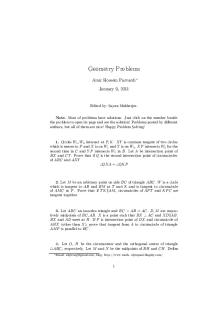
150 Geometry Problems With Solutions
- 23 Pages

Denny - Pemrograman Fuzzy
- 20 Pages

Test-de-ellis
- 12 Pages
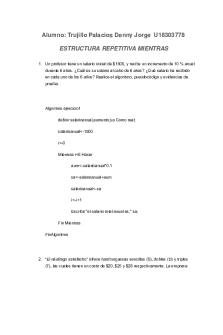
Denny tarea algoritmos semana 6
- 6 Pages
Popular Institutions
- Tinajero National High School - Annex
- Politeknik Caltex Riau
- Yokohama City University
- SGT University
- University of Al-Qadisiyah
- Divine Word College of Vigan
- Techniek College Rotterdam
- Universidade de Santiago
- Universiti Teknologi MARA Cawangan Johor Kampus Pasir Gudang
- Poltekkes Kemenkes Yogyakarta
- Baguio City National High School
- Colegio san marcos
- preparatoria uno
- Centro de Bachillerato Tecnológico Industrial y de Servicios No. 107
- Dalian Maritime University
- Quang Trung Secondary School
- Colegio Tecnológico en Informática
- Corporación Regional de Educación Superior
- Grupo CEDVA
- Dar Al Uloom University
- Centro de Estudios Preuniversitarios de la Universidad Nacional de Ingeniería
- 上智大学
- Aakash International School, Nuna Majara
- San Felipe Neri Catholic School
- Kang Chiao International School - New Taipei City
- Misamis Occidental National High School
- Institución Educativa Escuela Normal Juan Ladrilleros
- Kolehiyo ng Pantukan
- Batanes State College
- Instituto Continental
- Sekolah Menengah Kejuruan Kesehatan Kaltara (Tarakan)
- Colegio de La Inmaculada Concepcion - Cebu
